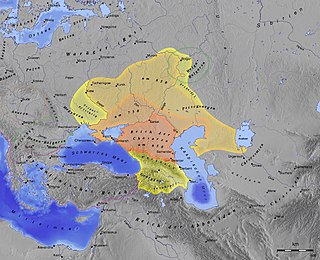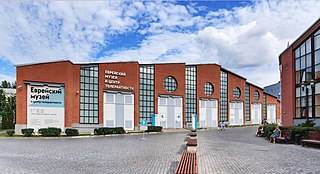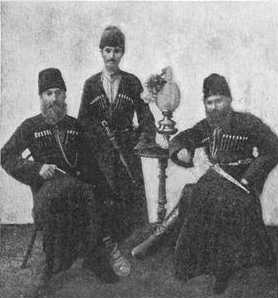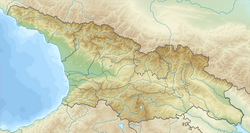
The Khazars were a nomadic Turkic people that, in the late 6th-century CE, established a major commercial empire covering the southeastern section of modern European Russia, southern Ukraine, Crimea, and Kazakhstan. They created what for its duration was the most powerful polity to emerge from the break-up of the Western Turkic Khaganate. Astride a major artery of commerce between Eastern Europe and Southwestern Asia, Khazaria became one of the foremost trading empires of the early medieval world, commanding the western marches of the Silk Road and playing a key commercial role as a crossroad between China, the Middle East and Kievan Rus'. For some three centuries the Khazars dominated the vast area extending from the Volga-Don steppes to the eastern Crimea and the northern Caucasus.

The history of the Jews in Russia and areas historically connected with it goes back at least 1,500 years. Jews in Russia have historically constituted a large religious and ethnic diaspora; the Russian Empire at one time hosted the largest population of Jews in the world. Within these territories, the primarily Ashkenazi Jewish communities of many different areas flourished and developed many of modern Judaism's most distinctive theological and cultural traditions, while also facing periods of antisemitic discriminatory policies and persecution, including violent pogroms. Some have described a "renaissance" in the Jewish community inside Russia since the beginning of the 21st century; however, the Russian Jewish population has experienced precipitous decline since the dissolution of the USSR which continues to this day, although it is still among the largest in Europe.

The history of the Jews in the Soviet Union is inextricably linked to much earlier expansionist policies of the Russian Empire conquering and ruling the eastern half of the European continent already before the Bolshevik Revolution of 1917. "For two centuries – wrote Zvi Gitelman – millions of Jews had lived under one entity, the Russian Empire and [its successor state] the USSR. They had now come under the jurisdiction of fifteen states, some of which had never existed and others that had passed out of existence in 1939." Before the revolutions of 1989 which resulted in the end of communist rule in Central and Eastern Europe, a number of these now sovereign countries constituted the component republics of the Soviet Union.

Cochin Jews are the oldest group of Jews in India, with roots that are claimed to date back to the time of King Solomon. The Cochin Jews settled in the Kingdom of Cochin in South India, now part of the present-day state of Kerala. As early as the 12th century, mention is made of the Jews in southern India by Benjamin of Tudela.

Bukharan Jews, in modern times called Bukharian Jews, are the Mizrahi Jewish sub-group of Central Asia that historically spoke Bukharian, a Judeo-Tajik dialect of the Tajik language, in turn a variety of the Persian language. Their name comes from the former Central Asian Emirate of Bukhara, which once had a sizable Jewish population. Bukharan Jews are of Persian-Jewish ancestry, though they are considered one of the oldest ethno-religious groups of Central Asia and over the centuries developed their own distinct culture.

The former communities of Jewish migrants and their descendants from Baghdad and elsewhere in the Middle East are traditionally called Baghdadi Jews or Iraqi Jews. They settled primarily in the ports and along the trade routes around the Indian Ocean and the South China Sea.

Bevis Marks Synagogue, officially Qahal Kadosh Sha'ar ha-Shamayim, is an Orthodox Jewish congregation and synagogue, located off Bevis Marks, Aldgate, in the City of London, England, in the United Kingdom. The congregation is affiliated to London's historic Spanish and Portuguese Jewish community and worships in the Sephardic rite.

Galician Jews or Galitzianers are members of the subgroup of Ashkenazi Jews originating and developed in the Kingdom of Galicia and Lodomeria and Bukovina from contemporary western Ukraine and from south-eastern Poland. Galicia proper, which was inhabited by Ruthenians, Poles and Jews, became a royal province within Austria-Hungary after the Partitions of Poland in the late 18th century. Galician Jews primarily spoke Yiddish.

The history of the Jews in Azerbaijan dates back many centuries. Today, Jews in Azerbaijan mainly consist of three distinct groups: Mountain Jews, the most sizable and most ancient group; Ashkenazi Jews, who settled in the area during the late 19th-early 20th centuries, and during World War II; and Georgian Jews who settled mainly in Baku during the early part of the 20th century.

The history of the Jews in the Czech lands, historically the Lands of the Bohemian Crown, including the modern Czech Republic, goes back many centuries. There is evidence that Jews have lived in Moravia and Bohemia since as early as the 10th century. Jewish communities flourished here specifically in the 16th and 17th centuries, and again in the late 19th and early 20th centuries. Local Jews were mostly murdered in the Holocaust, or exiled at various points. As of 2021, there were only about 2,300 Jews estimated to be living in the Czech Republic.

Temple Sinai is a Reform Jewish congregation and synagogue located at 3509 South Glencoe in Denver, Colorado, in the United States.
The Holocaust in Belarus refers to the systematic extermination of Jews living in the Byelorussian Soviet Socialist Republic during its occupation by Nazi Germany in World War II. It is estimated that roughly 800,000 Belarusian Jews were murdered during the Holocaust. However, other estimates place the number of Jews killed between 500,000 and 550,000.

Congregation Beth Israel is a Reform Jewish congregation and synagogue located at 5600 North Braeswood Boulevard, in Houston, Texas, in the United States. The congregation, founded in 1854, is the oldest Jewish congregation in Texas; and it operates the Shlenker School.

The Cheltenham Synagogue is an Orthodox Jewish congregation and synagogue, located on Synagogue Lane in St James's Square of Cheltenham, Gloucestershire, England, in the United Kingdom. The congregation was formed in 1820 and worships in the Ashkenazi rite.

The Lendava Synagogue is a former Orthodox Jewish congregation and synagogue, located in the small town of Lendava, Slovenia, a town that is close to the Hungarian border. The former congregation was established in 1773 and worshiped in the Ashkenazi rite. The former synagogue was completed in 1866 and was used as a synagogue up until 1944, when the community perished in The Holocaust.

The Tarnopol Ghetto was a Jewish World War II ghetto established in 1941 by the Schutzstaffel (SS) in the prewar Polish city of Tarnopol.

The Chicago Loop Synagogue is an Orthodox Jewish synagogue, located at 16 South Clark Street, in the Loop precinct of Chicago, Illinois, in the United States. Completed in 1958, the synagogue is renowned for a stained glass artwork by Abraham Rattner.
The anti-cosmopolitan campaign was an anti-Western campaign in the Soviet Union which began in late 1948 and has been widely described as a thinly disguised antisemitic purge. A large number of Jews were persecuted as Zionists or rootless cosmopolitans.

The history of the Jews in Odesa dates to 16th century. Since the modern city's founding in 1795, Odesa has been home to one of the largest population of Jews in what is today Ukraine. They comprised the largest ethno-religious group in the region throughout most of the 19th century and until the mid-20th century.

The Split Synagogue is an Orthodox Jewish synagogue, located in Split, Croatia. Built in the early 1500s, the synagogue is one of the oldest Sefardic synagogues in use today.



















